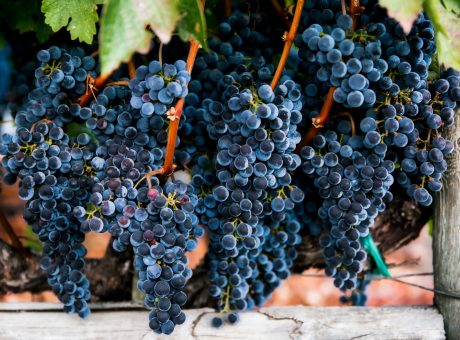The Beauty of Burgundy
Burgundy is one of the most well known wine regions in France. The region’s name alone is highly respected. The wines from this eastern region are also called “Burgundies” and come with many characteristics that are thought of as some of the most exclusive wines in the world. Although France may have made them famous, America and other countries have successfully produced fabulous wines from the same grape varietals used, but with a distinct difference in taste. Let’s take a look a look at the “original” Burgundy birthplace to get the feel of this complicated and often difficult to understand region.
The two types of wine from this region are the Pinot Noir (red burgundy) and Chardonnay (white burgundy). The Burgundy region has five well-known sub-regions, each one with its own personality and style. The terroir, (ter-wahr), climate and soil, is so diverse that it’s different from one vineyard to the next which allows these wines to express their true beauty when developed. The soils in Burgundy consist of clay, limestone and marls, and the climate can change just as quickly, which is ideal for the two grape varietals in the region.
The five regions that you probably will recognize on the wine label are:
Chablis – the northern most area in Burgundy. Chardonnay is the main grape and produces a wine with its name; aged in steel barrels
Cote d’Or– most famous for both its red and white wines. It is further divided into
- Cote de Nuits – situated in the northern half of the region. Red wines are predominately made here along with a small percentage of white, but the area is known for its red burgundy.
- Cote de Beaune – this is in the southern part of the region and best known for its fabulous whites, but also produces excellent reds.
Cote Chalonnaise – produces many good reds and whites at more reasonable prices.
Maconnais- produces many of the well-known whites at reasonable prices: Pouilly-Fuisse and Macon-Village; aged in steel barrels.
Beaujolais – although outside the traditional Burgundy region, farther south, it is usually categorized with the Burgundy wines. This area is known for producing fruit forward, vibrant red wines with berry-like flavors, while the white wines are known as Beaujolais Blanc.
 There are two main grapes used to produce a Burgundy:
There are two main grapes used to produce a Burgundy:
Chardonnay– produces the greatest white burgundy wines and is grown all over the world today. The terroir in Burgundy sets it apart from the New World-style wines. The cooler climate affects the grapes ripening and so produces a different flavor than say those grown in California or Australia.
Two types of Chardonnay are produced in Burgundy:
- Chablis – named for the northern region where it is grown, is known as some of the best in the world. It’s very dry with the taste of lemon and heavy minerality. It is traditionally not aged in oak barrels.
- Chardonnay – most commonly produced in Cote de Buene. This varietal is famous for its flavor, but different that Chablis because it’s aged in oak barrels with riper grapes, giving it a fuller, rounder taste.
Pinot Noir – this red burgundy is difficult to grow because of the very specific and particular terroir required to produce the best fruit, but extremely successful in Burgundy. It produces a taste different than anywhere else in the world with a certain earthiness and a subtle fruit flavor with fabulous acidity.
Burgundy wines are classified by the vineyard, not the Chateau, as seen in other wines, and vary greatly from one vineyard to the next. These wines are produced by either the individual vineyard owner or by merchants who buy the grapes and bottle it with their label. Both may produce an excellent wine. To help narrow down which ones you may want to try, look at the designations given to each:
Grand Cru – considered the greatest vineyards, located in the Cote d’Or region. There are more than 25 that produce reds and whites.
Premier Cru – next in prestige, produce both reds and whites. Many of these vineyards are located in the Cote Chalonnaise region.
Village wines have the name of the town where they were produced.
Regional appellations relate to groups of villages.
 Where to start with your exploration of Burgundy wines? It can get very complicated and overwhelming, but also very exciting because of the wide variety of choices and tastes. Each sub-region produces a different style of wine, which is what makes Burgundy so fascinating and the wines so exciting to taste.
Where to start with your exploration of Burgundy wines? It can get very complicated and overwhelming, but also very exciting because of the wide variety of choices and tastes. Each sub-region produces a different style of wine, which is what makes Burgundy so fascinating and the wines so exciting to taste.
Start your exploration with a Pinot Noir that has Cote d’Or, Cote Nuits or Cote de Beaune on the label. Don’t stop at just one, try a variety from different vineyards. Each will have a distinct flavor, but you are sure to find a favorite or two.
If you are looking for a white, first try one from Cote de Beaune and one from Chablis. The distinct differences will help you narrow down your search for a favorite. Then, again, try different ones from different producers to find your style.
Once you do this, then concentrate on particular villages and vineyards to really see the diversity in the wines produced in this region. Remember, the location of where the wine is grown and produced matters and can vary from vineyard to vineyard because of terroir.
After tackling the French Burgundy wines, don’t forget to try the New World Chardonnay. Try some from California or Australia, and really note the difference again in tastes on the Chardonnays. The French wines will be much more acidic and tangy, have less sugar, and be lighter bodied than New World wines. Some will taste oaky and others will not, the choice is huge and should not be overlooked.
We really could go on about Burgundy all day, as this region has so much to it, more than one article can fully explore. But, take this information and begin your journey, it will be well worth it.
– Sara Lehman





Leave A Comment